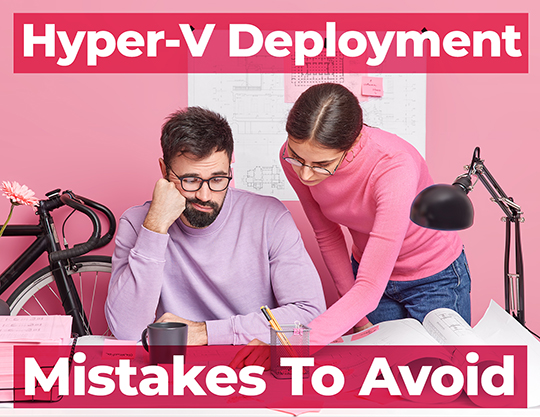It’s no coincidence that the virtual machines have experienced a surge in popularity with the launch of Microsoft Hyper-V. Roots of this incredibly powerful software can be traced back to 2003 when Microsoft acquired the privately-owned Connectix Corp.
This simple business acquisition paved the way for further development and research on virtual machines and is the main reason why they’re so popular today. In fact, Microsoft Hyper-V has simplified the process of setting up a virtual machine to such an extent that it only takes a few minutes to get a VM provisioned and running. That being said, this simplicity is also its biggest shortcoming as default configurations can leave a business horribly exposed to system crashes and errors. This has resulted in countless organizations using standard configurations that introduce many vulnerabilities and soft spots in their virtual machines. So, if you’re deploying Microsoft Hyper-V, make sure to avoid these ridiculously common mistakes.
-
Overloading the Management Operating System
In recent years, businesses have adopted the questionable practice of using their management operating system to run service. We strongly urge our readers not to follow this now industry norm as it can compromise their virtual machines. The only things you should run on your management operating system are virtual machines, backup solutions, and anti-virus software. For every other purpose, we advise our readers to use a hypervisor as this digital option can run up to 1024 virtual machines.
To accommodate services like software routing or web servers, we highly recommend choosing hypervisors or separate physical systems over management operating systems. And that concludes our list of common Hyper-V deployment mistakes. We believe that if you follow this simple guide, you can run virtual machines much more efficiently.
-
Mismanagement of Resources in Hyper-V
By far, the most common Hyper-V deployment we see is the mismanagement of hardware resources. Users have struggled to find the perfect balance between their CPU and system memory, and imbalances between network storage and network connectivity are also common. These imbalances can slow down your system and leave your virtual machines exposed to cyber-attacks.
-
Poor Utilization of Virtual Switches
Make no mistake about it, the Hyper-V virtual switch is a powerful feature which can be used to set up VLANs (Virtual Local Area Networks). Armed with powerful Ethernet frame switching functionality, these virtual switches can serve as uplinks thereby enabling communication between physical systems and virtual machines. The problem arises when companies can’t find an optimum number of virtual switches to have on their VMs. Often companies overload their servers with numerous, unneeded virtual adapters that drain precious resources and result in unnecessary virtual machine traffic. Therefore, it’s of the utmost importance that you use these switches in moderation so as to ensure smooth operation of your management operating system and virtual machines.
If you want to avoid a Hyper-V deployment disaster with a secure, reliable, and affordable Hyper-V backup to protect your production virtual machines then why not try CloudBacko backup solutions. CloudBacko also supports Microsoft 365 backup, Microsoft SQL Server backup, Microsoft Exchange database backup, Microsoft Windows System backup etc.
Contact CloudBacko today for more information about our backup and recovery solutions.
